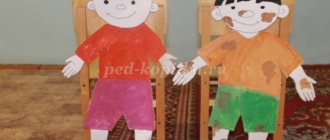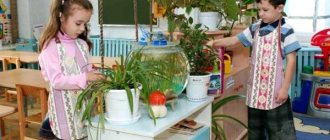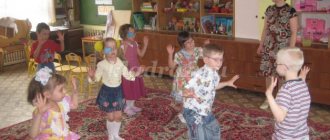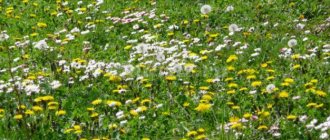Progress of the game:
Q: This bear willingly lies on its side, back, or stomach. We need to ask him about this.
Children ask for a bear using the verb LYAG
By complicating the task, the teacher creates a new game situation with any other toy
Name it in one word
Goal: to teach to enrich objects with one word, to enrich vocabulary.
Material: pictures of a piano, violin, drum, saw, axe, plane, sewing machine, scissors, needles, etc.
Regular moment “washing”
In the middle group, children have already developed basic self-care skills. They know how to wash their hands up to the elbows and their faces. The teacher makes sure that the children approach the washbasins one at a time and do not jostle. Great attention is paid to accuracy. Children should first roll up their sleeves, not splash water on the walls or floor, rinse off the soap suds under the tap, and carefully close it after finishing the procedure. You need to dry your hands with your towel, and then hang it up.
The teacher tells the children about the importance of personal hygiene and germs. Poems and riddles, as well as the introduction of a toy character who does not know how to wash himself, will help make the process interesting. Children should know that they wash their hands after going to the toilet, as well as after returning from a walk, before breakfast and lunch. It is worth paying attention to the neatness of your hairstyle. If after playing a child walks around disheveled, the teacher helps him comb his hair and braid his hair. It is necessary to convey to children that they should not use someone else’s comb or towel.
On the topic: methodological developments, presentations and notes
Goal: 1.Gradually include children in active activities, transferring from a state of inhibition to wakefulness.2. Arouse positive emotions in children, including music, thereby allowing the children to wake up. 3.Co.
Goal: 1.Gradually include children in active activities, transferring from a state of inhibition to wakefulness.2. Arouse positive emotions in children, including music, thereby allowing the children to wake up. 3.Co.
Author: Olga Anatolyevna Barabanova, teacher at MADOU kindergarten No. 1, Balakovo.
Synopsis of Awakening Gymnastics.
Gymnastics for waking up after a nap helps preschoolers instill the basics of a healthy lifestyle.
The summary describes gymnastics after naps for children of middle preschool age.
The summary of gymnastics for waking up after a nap presents exercises aimed at ensuring a comfortable awakening of children after a nap, lifting the mood, etc.
Source
Preview:
Municipal budgetary preschool educational institution "Kindergarten No. 15" of the city of Aleysk, Altai Territory
Consultation for teachers
Topic: Organization of routine moments in preschool educational institutions “Preparing for sleep and awakening gymnastics”
Organization of routine moments in the preschool educational institution “Preparing for sleep and awakening gymnastics”
Goal: To develop discipline in preschool children. Creating a calm environment and a positive mood before bed. Develop independence when undressing, accuracy when folding clothes. Cultivate kindness and respect for peers.
The period of preparation for bed should be calm and balanced. Children are not recommended to be distracted by noisy games or emotional conversations. When undressing, the teacher makes sure that the child frees his hair from bows, hairpins, etc.
Daytime sleep is one of the most important factors in the harmonious development of a child and helps to spend the rest of the day in a good mood.
The teacher promotes a calm and relaxing environment in the bedroom and a positive attitude towards daytime sleep. It is necessary to check whether the children are comfortable in their beds, or even better, approach each one, straighten the blanket, pat them on the head and wish them a restful sleep. It is best for a child to sleep on the right side with the body in an arched position. This is a natural, physiologically optimal position. Be sure to observe the child's breathing - it should be nasal. During the ritual of getting ready for bed, a calm melody or lullaby can be played in the group, setting the children up for rest. The teacher can tell them a familiar and beloved fairy tale in a quiet, calm voice. You can sing a lullaby. You should not ask children questions at this time, tell action-packed stories, or call children by name. The child falls asleep - this is a fragile phase of sleep, and it must be protected. Otherwise, the child will be artificially perked up, and then it will be very difficult for him to fall asleep.
The eyelashes droop and the eyes close. We rest peacefully, fall asleep in a magical sleep
Background music is playing, children are lying on rugs and listening to the fairy tale “Cinderella” by Charles Perrault
Carrying out the regime moment “Rising”
Goal: ensuring a smooth transition from sleep to wakefulness, a positive emotional mood, preparation for vigorous activity.
- Good afternoon! Wake up quickly! Smile wider at the sun!
With these words the teacher greets the waking children. Complexes based on a game plot and including elements of improvisation allow one to achieve maximum motor and emotional activity. The teacher accompanies the demonstration of exercises with an explanation. The number of repetitions of each movement depends on the desire and physical condition of the children. The complex is carried out within 5-7 minutes. Children do not wake up from naps all at once. And we try to ensure a smooth gradual recovery of each child from sleep. To do this, the teacher turns on quiet, calm music a few minutes before getting up. Gradually, as the children wake up, the volume of sounds increases. After the children wake up, awakening gymnastics are performed. This is a specially designed set of exercises that allows you to gradually warm up the muscles and lift the mood of children.
We all woke up together, smiled, stretched, (Movements corresponding to the text) Breathed deftly (Breathe through the nose) Hummed loudly (oo-oo-oo-oo) Raise your shoulders like grasshoppers in the grass. (Energetic movements of your shoulders up and down). The bear crawled out of the den and looked around at the threshold. (Lying in bed, throw the blanket to the side, turn his head to the right, left) He stretched from sleep Spring has come to us again (Hands up, stretched) To quickly gain strength, He twisted his legs (Movement “bicycle”) The bear scratched behind his ear, ( They imitate the movement of a bear) He wagged his tail slightly, (According to the text) He leaned back and forth, (Bends from a lying position) And with his legs he barely goes beyond the threshold. (Get out of bed) A bear is walking through the forest. This bear is looking for honey. (Walking in place with turning his head to the right, left) He is hungry, sad, Conversing with spring: (They walk out of the bedroom with a bearish step and growl) “Tell me, spring, Where can I get more honey? (Children move to the massage paths (prevention of flat feet): I see stumps, roots, There is no honey, no grass. "(They walk, bend over, look in “looking for honey”) The bear waved his arms, As if dispersing clouds. He drives them back and forth, Well , but he won’t find any honey. (Rotate with straight arms back and forth) He squatted lower, deeper, Found a swarm of bees (Squatted down, stood up) But the bee family drove the bear away. Breathing exercises:
2. “The ball inflated and burst.” Place your hands on your stomach, inhale, feeling that your stomach is inflated like a ball, and pronounce “sh-sh-sh” as you exhale.
Self-massage as one of the forms of health-saving technologies.
Stand one after another in a circle. Listen to the song and perform the movements we hear in the song! Get your fists and palms ready! (the song “Shishkopad”, composed by V.N. Mosin, sounds, children perform movements on each other’s backs, first in one direction, then in the other).
On the topic: methodological developments, presentations and notes
The regime is usually understood as a scientifically based routine of life, providing for a rational distribution in time and sequence of various types of activities and recreation. The child is accustomed to it.
These recommendations will help teachers (young professionals) become familiar with the peculiarities of organizing routine moments; their significance for the development of intellectual and physical qualities; pref.
Consultation for teachers on the topic “Organization of routine moments in a modern kindergarten.”
METHODOLOGICAL RECOMMENDATIONS FOR TEACHERS “The procedure for organizing routine moments in a preschool educational institution.”
The regime is usually understood as a scientifically based routine of life, providing for a rational distribution in time and sequence of various types of activities and recreation. The child is accustomed to it.
The regime is usually understood as a scientifically based routine of life, providing for a rational distribution in time and sequence of various types of activities and recreation. The child is accustomed to it.
Source






